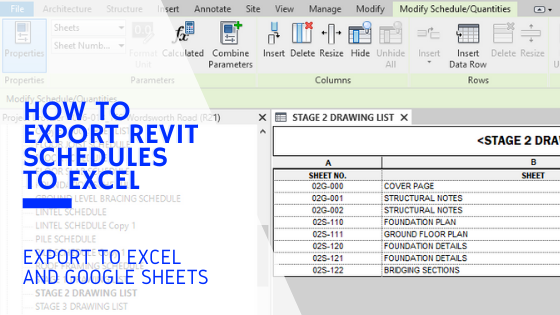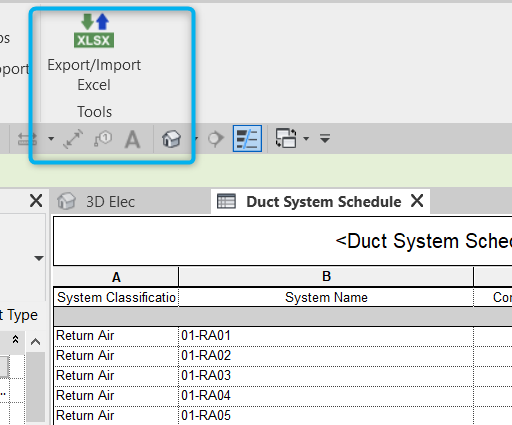Revit Add Ins: Broadening Your Design Capabilities
Wiki Article
Breaking Obstacles: Excel Importation Techniques for Advanced Revit Users
Are you an innovative Revit individual wanting to take your skills to the following degree? In this short article, we will show you just how to break obstacles by leveraging Excel for importation in Revit. Discover various information importation techniques and master Excel integration to boost your Revit modeling abilities. With our suggestions and methods, you can get over importation difficulties and come to be a true specialist in using Excel for your Revit projects. Prepare yourself to stand out in your Revit journey!Advanced Revit Users: Leveraging Excel for Importation
You can conveniently leverage Excel for importation as an innovative Revit user. Excel is a powerful device that can greatly improve your operations and efficiency in Revit. With its capability to take care of large quantities of information and perform complicated estimations, Excel can be a valuable possession in handling and arranging your project info.One method to utilize Excel for importation is by using the "Link Excel" function in Revit. This attribute allows you to link an Excel spreadsheet directly right into your Revit task, allowing you to update and synchronize data between both programs. When dealing with timetables or tracking adjustments in your task., this can be particularly useful.
Another method to use Excel is by utilizing the "Import/Export" function in Revit. This function enables you to import and export information in between Revit and Excel, providing you the versatility to collaborate with information in both programs. You can import information from Excel into Revit to produce aspects such as doors, wall surfaces, or spaces, and you can likewise export data from Revit to Excel for additional analysis or reporting.

Exploring Information Importation Approaches in Revit Making Use Of Excel
Exploring how to import information from Excel right into Revit supplies reliable approaches for incorporating details. When you import information from Excel, you can effortlessly move data such as space schedules, material lists, and tools information right into your Revit job. This process allows you to save time and effort by staying clear of manual information access.To import information from Excel into Revit, you can utilize the "Import/Export" attribute. This feature allows you to map the Excel information fields to the corresponding Revit criteria, making certain that the info is appropriately appointed within the version. By choosing the suitable import options, you can regulate exactly how the data is imported and just how it connects with your job.
An additional technique for importing information from Excel into Revit is by making use of Dynamo. With Eager beaver, you can create personalized scripts that import information from Excel and manipulate it within your Revit job.
Mastering Excel Combination for Advanced Revit Modeling
One essential method is importing information from Excel spread sheets straight into your Revit model. With a few basic actions, you can map the Excel columns to the equivalent Revit parameters and import the data precisely.One more beneficial approach is exporting information from Revit to Excel. This allows you to extract information from your model, such as routines or material quantities, and examine it in Excel utilizing solutions, graphes, or various other effective devices. By leveraging the capacities of Excel, you can execute intricate estimations, develop personalized records, and gain valuable understandings right into your task.
Along with information transfer, Excel assimilation can automate recurring jobs in Revit. By producing macros or manuscripts in Excel, you can automate processes like producing views, generating sheets, or applying basic families - revit tool. This not just saves time but also ensures consistency across your task
To understand Excel combination in Revit, it is vital to comprehend the data framework and just how Revit connects with Excel. By acquainting yourself with the available devices and methods, you can open the complete potential of Excel integration and take your Revit modeling to the following degree.
Overcoming Importation Obstacles: Excel Techniques for Revit Specialists
When getting rid of importation challenges, it is necessary to be accustomed to effective Excel techniques that can profit professionals in Revit. As an advanced Revit customer, you comprehend the importance of effortlessly importing data from Excel right into your jobs. However, you might encounter numerous challenges along the means. By utilizing effective Excel techniques, you can get rid of these obstacles and boost your productivity.
Another beneficial strategy is using the "Transpose" function in Excel. This permits you to transform data from rows to columns or the other way around. When importing information right into Revit, this can be particularly practical when you have information in a vertical style in Excel, however you require it to be in a straight format in Revit.
Moreover, making use of Excel solutions such as VLOOKUP and INDEX-MATCH can greatly help in mapping information from Excel to Revit. These solutions permit you to look for particular values in Excel and get equivalent information from another column. This can save you time and effort when importing big datasets right into Revit.
Excel Information Importation Tips and Tricks for Advanced Revit Users
By familiarizing yourself with efficient Excel pointers and methods, revit tool you can enhance your information importation procedure as a sophisticated user of Revit. In addition, making use of Excel's "Paste Special" feature permits you to paste information from Excel into Revit while keeping format, such as cell color or font design. One more valuable trick is to make use of Excel's "Change and discover" feature to swiftly make modifications to your information prior to importing it into Revit.
Verdict
You have now found out important strategies for importing data from Excel into Revit as an innovative user. Go ahead, damage those barriers and stand out in your Revit tasks!
When importing data into Revit, this can be especially helpful when you have data in an upright layout in Excel, but you need it to be in a straight layout in Revit.
Furthermore, using Excel solutions such as VLOOKUP and INDEX-MATCH can greatly assist in mapping data from Excel to Revit. In addition, making use of Excel's "Paste Special" feature enables you to paste information from Excel right into Revit while keeping format, such as cell color or font style.
Report this wiki page